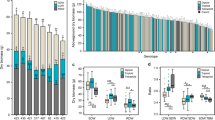Summary
Twenty-nine primary triticales (x Triticosecale Wittmack), derived from homozygous, uniform wheat and rye inbreds, were evaluated (i) to assess wheat, rye and interaction effects for yield-related characters, (ii) to estimate correlations between these characters, and (iii) to investigate the possibility of predicting micro-plot performance from early spaced-plant tests. The triticales (12 octoploid, 17 hexaploid) were tested under space-planting and in micro-plots in three-replicate, randomized block designs in 1983 and 1984, respectively. In general, hexaploid triticales performed significantly better than octoploids. Strong wheat and wheat x rye interaction effects were found, making it difficult to predict the performance of primary triticales from their constituent parental genotypes. At both ploidy levels under space-planting kernel weight per spike showed significant positive correlations with spikelets per spike, kernels per spikelet, and 1000-kernel weight. No significant associations were detected between spaced-plant and micro-plot performance for octoploids, indicating severe disorders at this ploidy level. In hexaploid triticales spikes per plant, kernel weight per spike, and kernels per spikelet observed in spaced-plants appeared to be useful indicators of grain yield in micro-plots.
Similar content being viewed by others
References
Baaren A.van, 1973. A computer program for least-squares analysis of non-orthogonal designs. EDV Med Biol 4: 16–27.
Carrillo J.M, A. Monteagudo & E. Sanchez-Monge, 1983. Inheritance of yield components and their relationship to plant height in hexaploid triticale. Z Pflanzenzüchtg 90: 153–165.
Jung C. & T. Lelley, 1985. Genetic interactions between wheat and rye genomes in triticale. Part 2. Morphological and yield characters. Theor Appl Genet 70: 427–432.
Jung C., T. Lelley & G. Röbbelen, 1985. Genetic interactions between wheat and rye genomes in triticale. Part 1. Cytological results. Theor Appl Genet 70: 422–426.
Oettler, G., 1986. Variation and covariation of agronomic characters in primary triticale and their wheat and rye parents. p. 120–123. In Int Trit Symp Sydney, Aust, 2–8 February 1986. Aust Inst Agri Sci Occasional Publ No 24.
Poysa V.W., C.J. Knoblauch, B.D. McKersie & E. Reinbergs, 1984. Low-temperature tolerance of octoploid triticale and its parental species grown in southern Ontario. Can J Plant Sci 64: 451–456.
Sandha G.S., D.S. Pannu & K.S. Gill, 1980. The assessment of continuous variability for grain yield and other characters in triticale. Cer Res Communications 8: 401–408.
Author information
Authors and Affiliations
Rights and permissions
About this article
Cite this article
Oettler, G., Geiger, H.H. & Singh, I.S. Analysis of spaced-plant and micro-plot performance for yield-related traits in octoploid and hexaploid primary triticales. Euphytica 38, 25–29 (1988). https://doi.org/10.1007/BF00024807
Received:
Accepted:
Issue Date:
DOI: https://doi.org/10.1007/BF00024807



